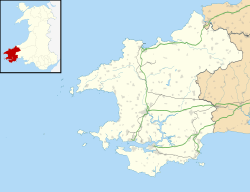| Waterston | |
|---|---|
 Waterston Methodist Chapel with Dragon LNG Terminal beyond | |
Location within Pembrokeshire | |
| Population | 335 |
| OS grid reference | SM939063 |
| Community |
|
| Principal area | |
| Country | Wales |
| Sovereign state | United Kingdom |
| Post town | Milford Haven |
| Postcode district | SA73 |
| Dialling code | 01646 |
| Police | Dyfed-Powys |
| Fire | Mid and West Wales |
| Ambulance | Welsh |
| UK Parliament | |
| Senedd Cymru – Welsh Parliament | |
Waterston is a village near Milford Haven in Pembrokeshire, Wales, in the community and parish [1] of Llanstadwell. It lies on the B4325 road linking Neyland and Milford Haven. [2]
